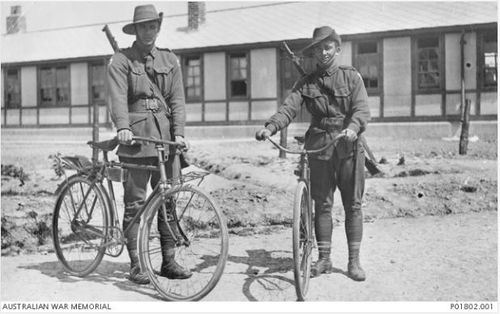Difference between revisions of "1st ANZAC Cyclist Battalion"
From Our Contribution
(→Unit Personnel) |
(→Notes) |
||
| Line 32: | Line 32: | ||
==Notes== | ==Notes== | ||
Content for the history and honours sections has come from a combination of Wikipedia and the Australian War Memorial websites. | Content for the history and honours sections has come from a combination of Wikipedia and the Australian War Memorial websites. | ||
| + | |||
| + | For further detail on the contribution of Cyclist units, see:<br> | ||
| + | * ''History of teh AIF/NZ Cyclist Corps 1916 - 1919'', by Ron Austin | ||
<references /> | <references /> | ||
Latest revision as of 17:22, 18 February 2022
 | |
 Henencourt, France 12 May 1917. Two members outside their barracks AWM P01802.001 | |
Brief History
The British New Army establishment that the AIF was reorganised under in 1916 provided for a company of cyclists for each Division. When they got to France, they were reorganised as Corps troops, with a Battalion for each Corps. There were two ANZACs at this time, hence two Corps. The cyclist battalions were organised like infantry, with four companies of four platoons. 1st ANZAC Cylist Battalion was formed from the 1st, 2nd, 3rd and 4th Cyclist Companies. When II ANZAC became XXII Corps in 1917, the Australian cyclists of the 2nd Cyclist Battalion returned to the Australian Corps as reinforcements.
The cyclists were mainly used as despatch riders. During semi-open warfare periods in 1917 and 1918, they operated similar to cavalry. A brigade column in an advance would have cyclists attached. They weren't as mobile or flexible as cavalry, but didn't cost as much to maintain either.[1]
Tasks of the unit included 'directing traffic, unloading railway wagons, harvesting hops for local families, and burying the dead'. The 1st ANZAC Cyclist Battalion never served in the front line as a fighting unit, but it was exposed to regular bombardments by artillery and aircraft. Cyclist detachments, however, took part in the last stages of the war, as the German Army retreated from the trench systems to the Hindenburg Line.
Thirteen men were killed in action. The 2nd Battalion (officered by New Zealanders) fared even less well with a loss of 59 dead.
Unit Personnel
- Richard Edgar Riley 12 May 1916 - 18 Feb 1919
- Hobart Turner 18 May - 6 Sep 1916
- Ernest James Brandon Bettenay ?? Jun - 30 Sep 1916
Notes
Content for the history and honours sections has come from a combination of Wikipedia and the Australian War Memorial websites.
For further detail on the contribution of Cyclist units, see:
- History of teh AIF/NZ Cyclist Corps 1916 - 1919, by Ron Austin
- ↑ Ross Mallett